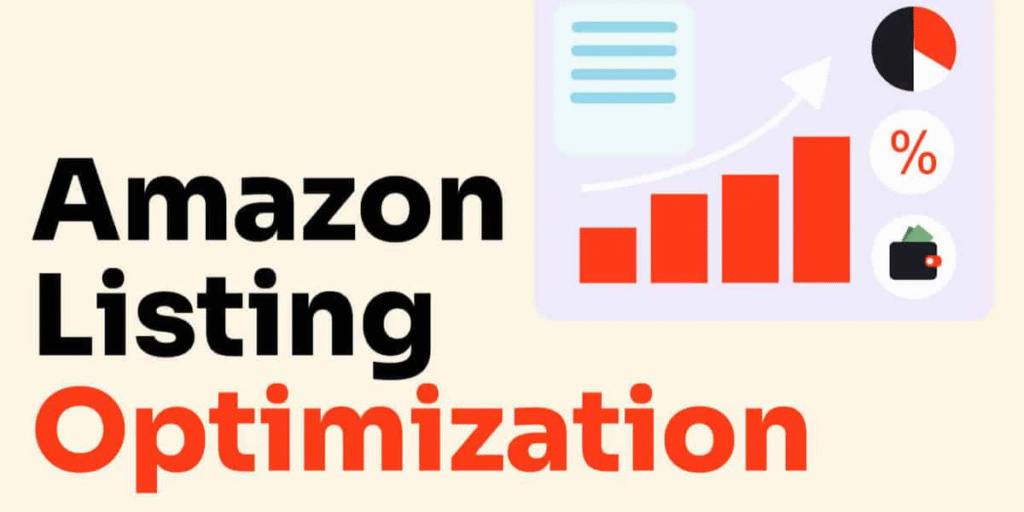Selling on Amazon in 2025 requires more than just uploading a product and hoping it sells. With millions of listings competing for attention, mastering Amazon listing optimization has become one of the most critical steps in achieving visibility, clicks, and conversions. If you’re serious about ranking high in Amazon search results, driving more sales, and maximizing ROI, this guide is your comprehensive blueprint.
Amazon continues to evolve, and so do its algorithms. In today’s competitive landscape, simply having good images or a compelling title isn’t enough. You need a holistic strategy that addresses every element of your product detail page.
Whether you’re launching your first product or looking to scale an existing store, this ultimate 2025 guide will show you everything you need to know about optimizing your Amazon listings for top performance.
What Is Amazon Listing Optimization?
Amazon listing optimization is the process of enhancing your product detail page to improve its visibility in search results and increase conversions. A well-optimized listing includes relevant keywords, appealing visuals, compelling copy, and backend data that align with Amazon’s A10 algorithm.
Optimization is not a one-time effort. It’s an ongoing process that includes updating images, monitoring competition, refining copy, testing A/B versions, and staying ahead of algorithm changes.
The goal is simple: rank higher for search terms that shoppers are typing into the Amazon search bar and convert more browsers into buyers once they land on your product page.
Why Listing Optimization Is Essential in 2025
As competition increases, Amazon’s marketplace continues to get saturated. Standing out in 2025 means you can’t rely on paid ads alone. Organic visibility is the long-term game, and that’s where optimization comes in.
The more relevant your listing is to a customer’s search, the more likely Amazon’s algorithm will push it to the top. In 2025, personalization is also at an all-time high. Amazon now tailors results based on user behavior, preferences, and shopping history. An optimized listing helps you become the preferred choice for more potential buyers.
It’s also cost-effective. Rather than pouring endless money into PPC campaigns, a well-optimized listing gives you sustainable organic traffic. This results in more profits, better ROI, and consistent sales.
Understanding Amazon’s A10 Algorithm
Amazon’s A10 algorithm powers the search and recommendation engine. In 2025, A10 puts a strong emphasis on relevance, buyer behavior, seller authority, and listing quality. It’s designed to prioritize listings that provide the best shopping experience.
Unlike previous versions, A10 places less weight on ad spend and more on organic performance. This means that factors like click-through rate, conversion rate, and customer retention play a bigger role than ever.
By optimizing your listing, you directly influence the signals that the A10 algorithm uses to rank products. Every keyword, image, and review matters.
The Core Elements of a High-Converting Amazon Listing
1. Product Title Optimization
Your product title is the first thing both Amazon and shoppers see. A well-optimized title includes your primary keyword, but also delivers clarity, benefits, and relevance. Your title must mirror what your ideal customer would search for.
Avoid keyword stuffing, which hurts readability. Instead, focus on writing a clear, concise title that reflects the core identity of the product. Ensure brand names, sizes, colors, or variations are mentioned naturally.
2. Product Images That Convert
In 2025, visuals are more powerful than ever. Amazon now supports video, 360-degree views, and lifestyle imagery on most listings. Customers want to see the product in action before they make a purchase decision.
Your main image should be clean and professional with a white background. Supplementary images should show different angles, use cases, and size comparisons. High-quality images reduce returns and boost trust.
Using infographic-style images with overlay text can highlight key benefits and address common concerns. Lifestyle images, especially for home, beauty, and fashion products, help shoppers visualize themselves using the product.
3. Bullet Points That Sell (Featured in Paragraphs)
While Amazon uses bullet points on the frontend, your optimization strategy should focus on how those features appear in your backend and copywriting. The purpose is to address shopper pain points, benefits, and use cases.
Each feature should focus on one core benefit. Use emotional triggers and powerful words that drive interest. Explain how your product solves problems and enhances the user experience. Think of the shopper’s journey and what objections they may have before buying.
4. Product Description and A+ Content
Your product description is more than a block of text. It’s a chance to sell. Use it to tell your brand story, highlight benefits, and support emotional buying triggers. Formatting is important to break content into digestible pieces.
A+ Content (formerly Enhanced Brand Content) allows brand-registered sellers to create visually rich listings with comparison charts, banners, and storytelling modules. It can increase conversion rates by up to 20%. Brands that invest in compelling A+ Content usually see fewer returns and higher satisfaction.
5. Backend Keywords and Search Terms
The backend of your listing is where you input hidden search terms. These don’t appear on the product page, but tell Amazon how to categorize your product. In 2025, backend optimization is more important due to increasing algorithm complexity.
Avoid repeating words already in your title or bullet points. Focus on alternate spellings, regional terms, misspellings, and secondary keywords. Amazon now also reads synonyms, so think like a buyer and cover every potential search angle.
Keyword Research for Amazon Listings in 2025
Effective keyword research is the foundation of Amazon listing optimization. Tools like Helium 10, Jungle Scout, and DataDive remain essential in 2025 for discovering trending keywords, search volume, and competition metrics.
Start by identifying your primary keyword—the one most relevant and high in search volume. Then build a list of related and long-tail keywords. These often have lower competition and can bring in targeted traffic.
Use tools to reverse-engineer competitor listings. See what keywords are driving their sales and identify gaps you can exploit. Continually update your keyword strategy based on seasonal trends, customer feedback, and market shifts.
Mobile Optimization
More than 70% of Amazon purchases in 2025 are made via mobile devices. That means your listing must look great on smaller screens. Keep your titles readable, images properly sized, and descriptions structured for easy scanning.
A+ Content should be mobile-responsive and load quickly. Use less clutter, more visual cues, and tighter formatting. If your listing doesn’t convert on mobile, you’re missing the majority of potential customers.
The Role of Reviews and Ratings
Reviews aren’t just social proof, they’re a major ranking factor. The A10 algorithm favors listings with higher ratings and engagement. Listings with more recent, positive reviews tend to rank better and convert more.
Encourage reviews through follow-up email automation (within Amazon TOS), product inserts, and exceptional service. Avoid incentivized reviews or shady tactics they can result in bans or suppression.
In 2025, Amazon gives more visibility to detailed reviews, videos, and customer-uploaded images. These build trust and give future buyers more confidence.
Listing Variations and Parent-Child Relationships
Using parent-child variations can streamline your catalog and boost visibility. Products with multiple colors, sizes, or flavors can be grouped under one parent listing. This drives more cross-traffic and strengthens listing authority.
Be strategic in creating variations. Ensure all child listings are genuinely similar and meet Amazon’s guidelines. Improper use of variations can lead to penalties or listing removal.
Using Video in Your Listings
Amazon now encourages video content for almost all categories. Adding product demo videos, customer testimonials, or how-to guides increases engagement.
Shoppers are more likely to convert after watching a short, informative video. Keep videos under 60 seconds, highlight the main benefits, and include captions for better accessibility.
Video content also helps reduce returns, especially for complex or technical products.
A/B Testing Your Amazon Listings
Amazon Experiments (formerly A/B testing) allows brand-registered sellers to test different versions of titles, images, bullet points, and A+ Content. This data-driven feature helps you determine what resonates most with your audience.
Run experiments for 7–10 days and analyze click-through and conversion rates. Make adjustments based on the data, not assumptions. Optimization is ongoing, and testing ensures your listing is always evolving with buyer behavior.
Monitoring and Updating Listings Regularly
Don’t set and forget your Amazon listing. Algorithms, customer trends, and competitors change often. Regular audits are necessary to stay on top.
Check your keyword rankings monthly. Monitor competitors for changes in pricing, imagery, or reviews. Refresh your A+ Content quarterly to align with seasons or promotions.
Consistent monitoring ensures your listing remains optimized and profitable over the long term.
Conclusion
Amazon listing optimization in 2025 is no longer optional, it’s essential. To win in this hyper-competitive marketplace, sellers must fine-tune every part of their product detail page. From keyword-rich titles and professional imagery to compelling copy and backend search terms, every element plays a vital role in increasing your ranking, click-through rate, and conversions.
By staying informed, testing regularly, and evolving with Amazon’s algorithm, you can build a powerful, sustainable presence on the world’s largest e-commerce platform.
For expert Amazon listing optimization services, feel free to reach out. Let Amazon Listing Services help you build listings that sell and scale.
FAQs
What is the most important part of an Amazon listing?
While all elements are important, your title, images, and main keywords are the most impactful for ranking and conversions. These are the first things a shopper sees and what the algorithm prioritizes.
How often should I update my listing?
At minimum, review your listing every 30–60 days. Update keywords based on trends, refresh images seasonally, and run A/B tests quarterly to keep your conversion rate high.
Does Amazon penalize for keyword stuffing?
Yes, keyword stuffing can hurt your ranking and readability. Amazon prefers clear, natural language that aligns with customer search behavior. Focus on relevance and user experience.
Can I optimize listings without being brand-registered?
Yes, but brand-registered sellers have access to tools like A+ Content, Brand Analytics, and Amazon Experiments. These give a competitive edge in optimization and data insights.
Is using videos on my listing mandatory?
No, but it’s highly recommended. Videos increase engagement, reduce returns, and boost conversions. Most top-ranking listings in 2025 include at least one video.




